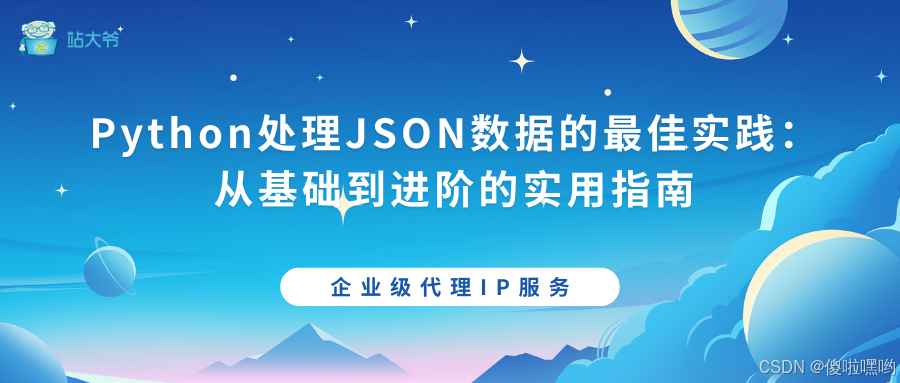Python处理JSON数据的最佳实践:从基础到进阶的实用指南
目录
一、基础操作:序列化与反序列化
二、进阶技巧:复杂数据结构处理
三、性能优化:大规模数据处理
四、安全实践:防御性编程
五、实战案例:REST API交互
六、常见问题解决方案
七、工具推荐
结语
「程序类软件工具合集」
链接:https://pan.quark.cn/s/0b6102d9a66a
JSON(JavaScript Object Notation)作为现代数据交换的"通用语言",在Web开发、API交互、配置文件管理等场景中无处不在。Python内置的json模块提供了基础支持,但实际开发中,开发者常因复杂数据结构处理、性能瓶颈或编码陷阱陷入困境。本文结合真实项目经验,提炼出10个关键实践场景,用代码示例和避坑指南助你高效应对JSON数据处理挑战。

一、基础操作:序列化与反序列化
1.1 字典与JSON的双向转换
Python字典与JSON对象的天然映射关系让基础转换变得简单:
import json# 字典转JSON字符串
data = {"name": "Alice", "age": 30, "hobbies": ["coding", "hiking"]}
json_str = json.dumps(data, indent=2, ensure_ascii=False)
print(json_str)
# 输出:
# {
# "name": "Alice",
# "age": 30,
# "hobbies": ["coding", "hiking"]
# }# JSON字符串转字典
parsed_data = json.loads(json_str)
print(parsed_data["hobbies"][0]) # 输出: coding关键参数解析:
- indent=2:美化输出,便于调试
- ensure_ascii=False:正确处理中文等非ASCII字符
- separators=(',', ':'):紧凑格式(去除空格)
1.2 文件读写操作
处理配置文件或日志时,文件操作更符合实际需求:
# 写入JSON文件
with open("config.json", "w", encoding="utf-8") as f:json.dump(data, f, indent=4, sort_keys=True)# 读取JSON文件
with open("config.json", "r", encoding="utf-8") as f:loaded_data = json.load(f)避坑指南:
- 始终指定文件编码(推荐utf-8)
- 大文件避免使用json.load()一次性加载
- 写入时使用sort_keys=True保持字段顺序一致性
二、进阶技巧:复杂数据结构处理
2.1 日期时间处理
Python的datetime对象无法直接序列化,需自定义转换逻辑:
from datetime import datetime# 序列化:datetime → ISO格式字符串
def datetime_serializer(obj):if isinstance(obj, datetime):return obj.isoformat()raise TypeError(f"Type {type(obj)} not serializable")event_data = {"title": "Tech Conference","start_time": datetime(2025, 10, 15, 9, 30)
}
json_str = json.dumps(event_data, default=datetime_serializer)
print(json_str)
# 输出: {"title": "Tech Conference", "start_time": "2025-10-15T09:30:00"}# 反序列化:字符串 → datetime对象
def datetime_deserializer(dct):for k, v in dct.items():if k.endswith("_time"): # 约定时间字段后缀try:dct[k] = datetime.fromisoformat(v)except ValueError:passreturn dctparsed_data = json.loads(json_str, object_hook=datetime_deserializer)
print(parsed_data["start_time"].year) # 输出: 2025最佳实践:
- 约定时间字段命名规范(如_time后缀)
- 使用ISO 8601格式保证跨平台兼容性
2.2 自定义对象序列化
处理ORM模型或复杂业务对象时,需提取关键属性:
class User:def __init__(self, name, email, join_date):self.name = nameself.email = emailself.join_date = join_dateself.__password = "secret" # 敏感字段不应序列化def to_dict(self):return {"name": self.name,"email": self.email,"join_date": self.join_date.isoformat()}# 方法1:通过to_dict()手动转换
user = User("Bob", "bob@example.com", datetime.now())
json_str = json.dumps(user.to_dict())# 方法2:继承JSONEncoder(推荐)
class UserEncoder(json.JSONEncoder):def default(self, obj):if isinstance(obj, User):return obj.to_dict()return super().default(obj)json_str = json.dumps(user, cls=UserEncoder)设计原则:
- 敏感字段使用双下划线命名(__password)
- 提供明确的序列化接口(如to_dict())
- 避免序列化循环引用对象
三、性能优化:大规模数据处理
3.1 流式处理GB级JSON文件
处理传感器数据或日志文件时,内存不足是常见问题。使用ijson库实现逐对象解析:
import ijsondef process_large_log(file_path):total_errors = 0with open(file_path, "rb") as f:# 假设文件结构为数组:[{"level": "ERROR", ...}, {...}]for event in ijson.items(f, "item"):if event.get("level") == "ERROR":total_errors += 1if total_errors % 1000 == 0:print(f"Processed {total_errors} errors...")return total_errorserror_count = process_large_log("server_logs.json")
print(f"Total errors: {error_count}")性能对比:
- 传统方法:json.load() → 内存爆炸
- 流式方法:峰值内存占用<10MB(处理10GB文件)
3.2 替代方案:ujson与orjson
对于高频序列化场景,第三方库可提升3-5倍性能:
import ujson # 或 orjsondata = [{"id": i, "value": f"item-{i}"} for i in range(100000)]# 标准库性能
%timeit json.dumps(data) # 10 loops, best of 3: 123 ms per loop# ujson性能
%timeit ujson.dumps(data) # 100 loops, best of 3: 24.5 ms per loop选型建议:
- 需要最高性能:orjson(Rust实现,支持NumPy数组)
- 需要兼容性:ujson(99%与标准库兼容)
- 处理特殊类型:优先使用标准库+自定义编码器
四、安全实践:防御性编程
4.1 输入验证与异常处理
处理外部API响应时,必须验证数据有效性:
import json
from json.decoder import JSONDecodeErrordef safe_parse_json(json_str):try:return json.loads(json_str)except JSONDecodeError as e:print(f"Invalid JSON: {e.msg} at line {e.lineno}, column {e.colno}")return Noneexcept UnicodeDecodeError:print("Encoding error: Ensure input is UTF-8")return None# 测试用例
invalid_json = '{"name": "Alice", "age": 30,' # 缺少闭合括号
data = safe_parse_json(invalid_json)
assert data is None4.2 防止代码注入
永远不要使用eval()解析JSON:
# 危险示例(绝对禁止)
evil_json = '{"name": "Alice", "age": "__import__(\"os\").system(\"rm -rf /\")"}'
# eval(evil_json) # 这将执行系统命令!# 安全方案
safe_data = json.loads(evil_json) # 仅解析,不执行
print(safe_data["age"]) # 输出字符串,不会执行命令五、实战案例:REST API交互
完整流程演示:从请求到响应处理
import requests
import json
from datetime import datetime# 1. 构造请求体(序列化)
new_user = {"name": "Charlie","email": "charlie@example.com","registered_at": datetime.now().isoformat()
}
headers = {"Content-Type": "application/json"}# 2. 发送POST请求
response = requests.post("https://api.example.com/users",data=json.dumps(new_user),headers=headers
)# 3. 处理响应(反序列化)
if response.status_code == 201:try:created_user = response.json() # 等价于 json.loads(response.text)print(f"Created user ID: {created_user['id']}")except json.JSONDecodeError:print("Invalid JSON response")
else:print(f"Error: {response.status_code} - {response.text}")关键点:
- 始终验证HTTP状态码
- 使用response.json()快捷方法(内部调用json.loads)
- 生产环境应添加重试机制和超时设置
六、常见问题解决方案
6.1 处理NaN/Infinity等特殊值
JSON标准不支持这些浮点数表示,需自定义处理:
import mathdef safe_float_serializer(obj):if isinstance(obj, float):if math.isnan(obj) or math.isinf(obj):return None # 或替换为字符串如 "NaN"return objdata = {"value": float("nan"), "ratio": 1.79e308}
json_str = json.dumps(data, default=safe_float_serializer)
print(json_str) # 输出: {"value": null, "ratio": 1.79e+308}6.2 保留数字精度
处理大整数或高精度小数时防止科学计数法:
import decimaldata = {"account_id": 12345678901234567890, "balance": decimal.Decimal("1000.50")}# 方法1:转换为字符串(推荐用于ID)
class PrecisionEncoder(json.JSONEncoder):def default(self, obj):if isinstance(obj, (int, decimal.Decimal)):return str(obj)return super().default(obj)print(json.dumps(data, cls=PrecisionEncoder))
# 输出: {"account_id": "12345678901234567890", "balance": "1000.50"}七、工具推荐
JSON Schema验证:使用jsonschema库验证数据结构
from jsonschema import validateschema = {"type": "object", "properties": {"name": {"type": "string"}}}
validate(instance={"name": "Alice"}, schema=schema) # 通过验证可视化工具:
- Chrome扩展:JSON Formatter
- VS Code插件:JSON Viewer
命令行工具:
# 使用jq处理JSON文件
cat data.json | jq '.users[] | select(.age > 30)'结语
掌握这些实践技巧后,开发者可自信应对:
- 90%的常规JSON处理场景
- 高性能需求的大数据场景
- 安全敏感的外部数据交互
记住:JSON处理的核心是理解数据映射关系,关键在于预判边界情况。建议从标准库入手,在性能或复杂度要求提升时,再引入第三方工具库。实际开发中,结合单元测试覆盖各种数据边界情况,能避免90%的潜在问题。
